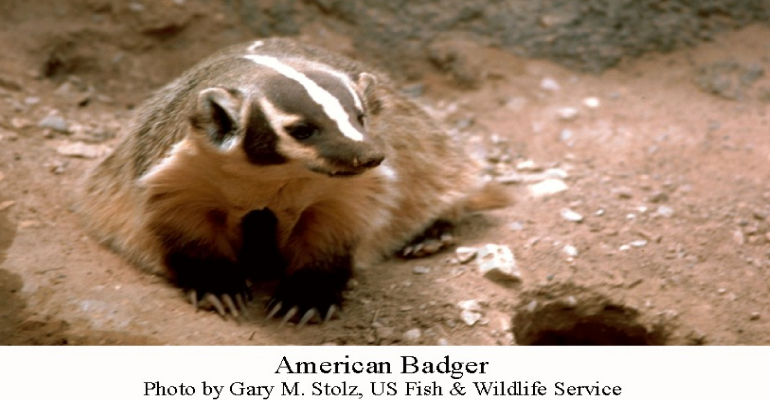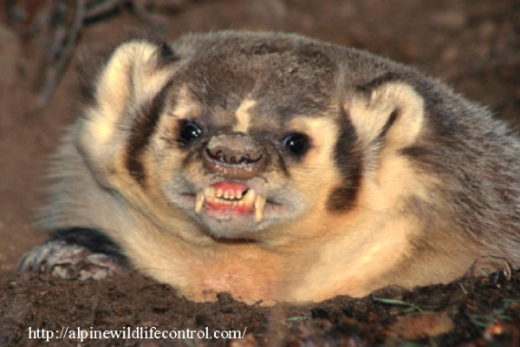
The American badger (Taxidea taxus) is known for its tenacity, power, and occasional ill-temper. The badger is a member of the Mustelidae family which includes skunks, otters, ferrets and weasels. There are four sub-species of badgers in North America which differ slightly in the size of the skull and color patterns of the fur.
The American badger is a carnivore and makes its living by digging for burrowing animals such as rodents, ground squirrels, prairie dogs, rabbits, and gophers. Given the opportunity, it will also prey upon, reptiles, birds and insects. It is preyed upon by eagles, cougars, and bobcats, but sometimes the badger can intimidate the predator with its hisses, growls, squeals and snarls and formidable teeth so that those predators leave it alone.
The American badger adult is about two feet long and weighs about 20 pounds. It has a wide body and short legs. It has a distinctive white stripe from forehead to nose. Its front feet carry curved claws up to two inches long, while the rear claws are shovel-shaped. Its fur is thick and shaggy.
According to the Arizona-Sonora Desert Museum (ASDM):
“Its eyes are equipped with nictitating membranes (transparent third eyelids) to protect them from flying dirt while the badger is digging. Small, well-furred ears also keep dirt out while the badger tunnels. A badger is able to secrete a musky scent from its anal glands, but it can’t spray this fluid like skunks can.”
According to DesertUSA:
 “The American badger ranges across the western two thirds of the United States, the southern third of Canada’s western provinces, and northern mountain ranges in Mexico.”
“The American badger ranges across the western two thirds of the United States, the southern third of Canada’s western provinces, and northern mountain ranges in Mexico.”
“Within its habitat, the male badger often stakes out a territory of a square mile or more; the female, somewhat less. The male badger’s territory may overlap that of several females. It does not appear to mount especially aggressive defenses of its territory.”
“The badger, following a solitary lifestyle, ranges and hunts primarily at night. If it has no family, it may dig itself a new den, each with one entrance, virtually every day during the summer, when it is most active. It digs fewer dens in the fall as days begin to cool and its activity level declines. It may dig only a single den for most of the winter when temperatures become chilly to frigid, and its activity level falls to minimal. Although the badger does not hibernate, it may remain in its winter den for days or weeks without emerging. Fastidious, the animal, like a house cat, buries its droppings, and it often grooms itself.”
“Bearing total responsibility for rearing the young, the female prepares an elaborate burrow for her family. She may, in fact, dig 10 feet below the surface and excavate 30 or more feet of passageways. She fashions a grass-lined chamber for her offspring, which are born blind and helpless, bearing only a thin coat of fur and weighing only a few ounces. She nurses the youngsters for two or three months.”
See photos from NatureWorks.
The High Desert Museum in Oregon has a short video (badger on a leash):
About their temper: ASDM notes “Few animals care to tangle with an enraged badger. One badger even attacked a tractor that inadvertently ran over its den entrance.”
Related articles:
Note to readers: I have constructed a linked index to more than 300 of my ADI articles. You can see it at: https://wryheat.wordpress.com/adi-index/
Have a look and see if there is some natural history subject of interest I haven’t yet written about.
